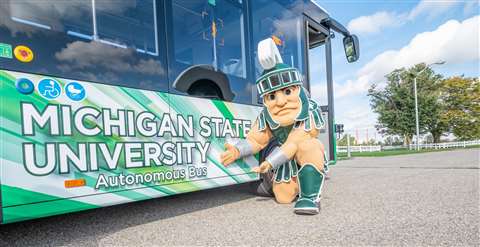Karsan autonomous bus to be deployed at Michigan State
30 November 2021
Campus’ new E-Atak bus is autonomous, battery-powered.
 Michigan State University said it will deploy an autonomous bus on its campus in early 2022.
Michigan State University said it will deploy an autonomous bus on its campus in early 2022.
Michigan State University (MSU) has announced that it will deploy a battery-electric autonomous bus to serve students, staff and faculty beginning early 2022. Part of the university’s smart mobility ecosystem, it said the bus represents one of the largest electric autonomous transit vehicles to be deployed on U.S. roadways to date.
Through its collaboration with the state of Michigan, Turkish bus manufacturer Karsan and ADASTEC, a San Francisco-based company delivering automated transportation platforms for full size commercial vehicles, MSU said it will officially deploy the bus after completing intense on-campus testing and National Highway Traffic Safety Administration validation of the bus, route and infrastructure.
“The mobility space is a core focus at MSU and we continue to seek out partnerships that accelerate our research and development efforts and enhance the mobility landscape not only on our campus but throughout our beautiful state and the country,” said MSU President Samuel Stanley Jr., MD. “This new autonomous bus symbolizes the types of advancements we’ve made at Michigan State to be on the cutting edge of the transportation of tomorrow.”
The Karsan Autonomous e-Atak bus will complement MSU Mobility’s efforts to test, validate and research all areas of mobility via its connected ecosystem, featuring 8.1 square miles of contiguous urban, suburban, industrial and rural zones. Data that MSU plans to collect and analyze from the bus includes V2I (vehicle to infrastructure) communication technologies as well as experiential learning from persons with disabilities to inform future design considerations.
“We are incredibly pleased to partner with Karsan and ADASTEC to bring another level of mobility to campus,” said Satish Udpa, interim director of MSU Mobility and University Distinguished Professor of electrical and computer engineering and Member of the State of Michigan’s Council on Future Mobility and Electrification. “This will offer our students a firsthand look at the future of mobility and give us the tremendous opportunity to analyze real world autonomous driving data, supporting a host of R&D initiatives on campus.”
The bus has 22 seats, with passengers being able to board and depart the bus at two stations. The bus’s 2.5-mile route will run non-stop, roundtrip from the MSU Auditorium to the MSU Commuter Lot (No. 89) at the intersection of Farm Lane and Mt. Hope, which houses what MSU said is the largest solar carport array in North America. To make the non-stop route possible, all traffic lights along the route will be controlled through intelligent roadside units and will actively communicate with the bus to improve its safety. To ensure optimal safety, a driver from ADASTEC’s Detroit office will be always present onboard, prepared to take control if needed.
The bus, offering Level 4 autonomy – meaning it can operate without any human interaction – was developed and produced by Karsan and updated with ADASTEC’s advanced autonomous technologies. Designed for large-scale public transport, the ADASTEC open automated bus platform, named flowride.ai, offers bus manufacturers opportunities to best meet the needs of next-generation automated public transportation. Additionally, the cloud-based platform supports data sharing, mission control and fleet management operations.
“We are excited to expand our reach into Michigan and partner on this pilot project with one of the leading universities in the mobility space to assist in its pursuit of an autonomous, sustainable future,” said Dr. Ali Peker, CEO of ADASTEC. “The MSU campus offers the ideal environment for proving the capabilities of autonomous transportation in a connected, diverse and real-world setting.”
Students, faculty and the general public are expected to be able to ride the bus beginning spring semester 2022, which begins in January, after rigorous testing and validation is complete.
A $100,000 grant through the Michigan Office of Mobility and Electrification, which was awarded to ADASTEC, helped make this collaboration possible. The bus was initially slated to arrive on campus at the beginning of the year but was delayed due to the pandemic.
“Having an electric autonomous bus of this scale in our backyard is incredible. It gives us a hands-on tool that can help educate MSU students and staff members as well as the surrounding communities about the importance and applicability of vehicles of this kind in our society,” said Trevor Pawl, Michigan’s Chief Mobility Officer. “MSU’s connected campus is an asset to proving out autonomous technology and helping us realize the full potential of this type of public transportation.”
Designed and manufactured in Turkey, the Autonomous e-Atak is a low-floor bus that uses five battery packs with BMW lithium-ion batteries rated 360v, 220 kWh to drive a Dana TM4 electric motor rated for 115 kW continuous power with 2500 Nm of torque.
“Having our 27 ft. Karsan Autonomous e-Atak bus on a campus of this size will be a tremendous showcase of its capabilities. Regardless of the outer conditions, Autonomous e-Atak can intelligently drive its route without human intervention,” said Okan Baş, CEO of Karsan.
To help keep its eyes on the road at all times, the bus is equipped with:
- Lidar : The Lidar in Autonomous e-Atak carries out the activities of detecting bicycles, people or inanimate objects, map-area mapping, location determination and environment detection.
- Camera : All eyes of Autonomous e-Atak perform the tasks of object detection, color detection, object classification and lane information recognition with RGB and thermal camera on the road.
- IMU : Used for acceleration, rotation speed calculation and position information.
- GNSS : GNSS (Global Navigation Satellite System) is used to observe where the vehicle is while driving.
- Radar: Radar, one of the main sensors of Autonomous e-Atak, is used in emergency braking, dynamic cruise control assistance and speed-dependent vehicle tracking by measuring the distance of objects to the radar.
- Ultrasonic sensor : These are the sensors that support the detection of objects at close range. It is actively used in low-speed cruising scenarios.
“With our vision of always being one step ahead in the future of mobility, we are shaping the future of transportation with the innovative products we have developed as Karsan,” said Baş. “We are proud that our Autonomous e-Atak vehicle will be used on the huge campus of Michigan State University, one of the important universities of the USA, where the pulse of the automotive and technology world is located and where real traffic conditions are located.”
STAY CONNECTED




Receive the information you need when you need it through our world-leading magazines, newsletters and daily briefings.
POWER SOURCING GUIDE
The trusted reference and buyer’s guide for 83 years
The original “desktop search engine,” guiding nearly 10,000 users in more than 90 countries it is the primary reference for specifications and details on all the components that go into engine systems.
Visit Now
CONNECT WITH THE TEAM










